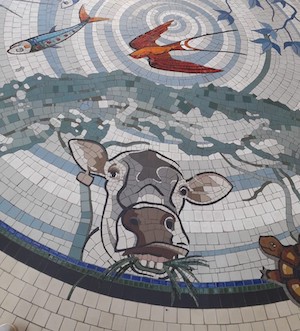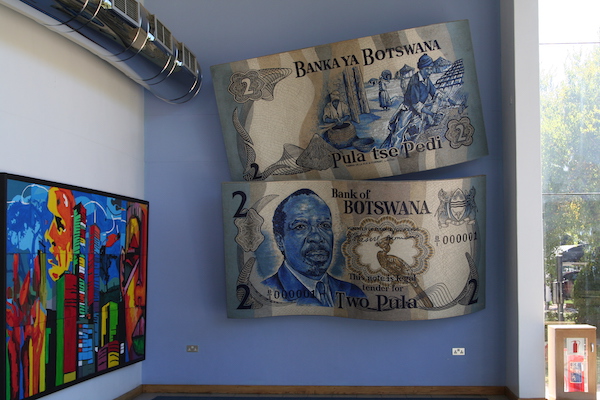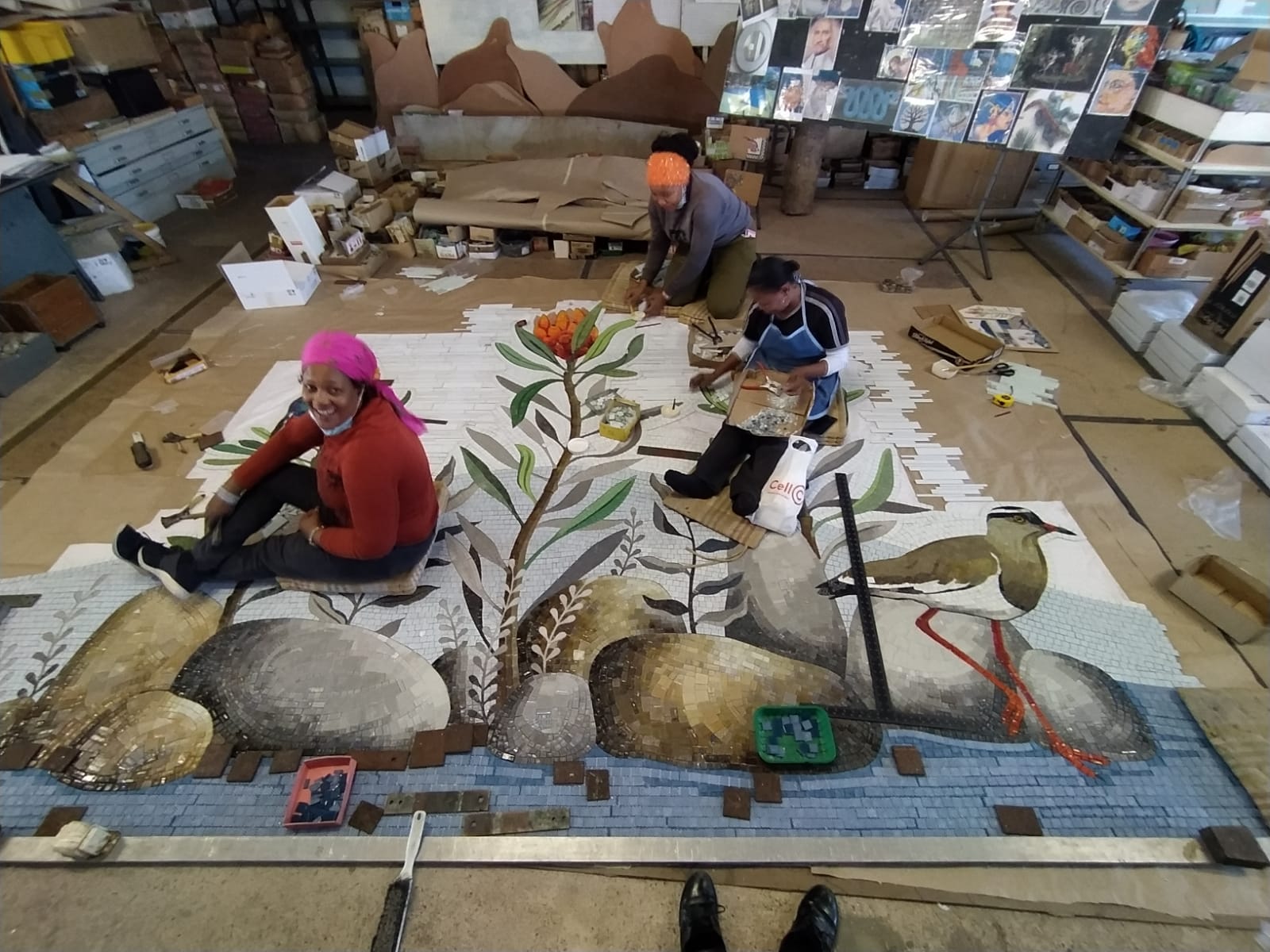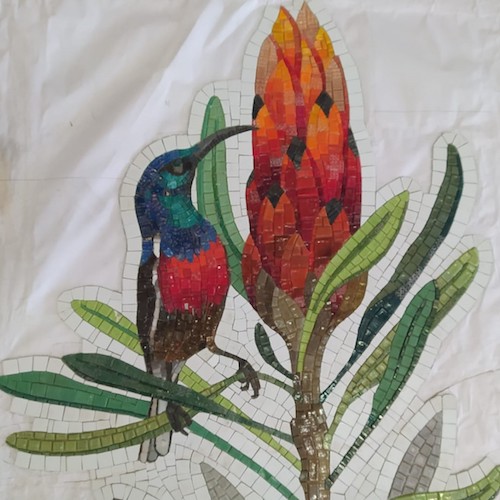

Megan Greenwood (www.mgcoaching.org) enjoys accompanying people as they discover how to live more deeply from their core. For more about Mosaic Arts, visit www.mosaicarts.co.za and Instagram: mosaic_arts_pretoria. Photographs by Marina Ehlers, unless specified otherwise.

December 2020: I locked my car, greeted the nearby car guard, and made my way for the first time to Irene Village Mall in Centurion, South Africa. Passing a merry-go-round, a colourfully patterned fountain greeted me. Behind it, I noticed a statue comprising four hoofed legs and the udder of an upside-down cow protruding out of the ground. Did the sculptor know about cow-tipping, the purported pastime of sneaking up to unsuspecting sleeping, standing cows and turning them over? I mused. If so, this was a refreshing take on this urban legend.
I stopped by the mall’s bathroom, seeing the cow theme continue: cheerful cows danced across the wall by the bathroom entrance. On subsequent trips to this mall, I noted its logo – a silhouetted, frolicking cow frozen in mid-jump. I also saw other whimsical objects, such as Henry-Moore-like sheep and horse sculptures just the right height and shape for kids to jump on for a ride. Perhaps this place could have been named the Moo Mall, I pondered, given its light-hearted inclusion of cows and farm animals.
Contemplating further, the cow theme made sense – most likely it was paying homage to Irene Farm, a nearby dairy farm with over 120 years of history. I wondered what the creative process behind its playful homage was.


1960s – 1990s: Renato Giovitto and Vera Valli Lurani grew up less than five kilometres apart near the foothills of the Italian Alps, yet their paths only crossed as young adults. By age 12, Vera was helping her father in Lestans’ fields to support her family. For her and other young women in this village, prospects were to become childminders or housecleaners. Born in Castelnovo Del Fruili, Renato attended four years at the Scuola Mosaicisti del Friuli training as a mosaic artisan. In 1958, he made his way to the southern tip of Africa in search of better prospects than in post-war Europe, bringing his specialisation in mosaics made from natural stones and smalti with him. On a return trip to Italy, Renato met his future wife, Vera. For two years they corresponded via letters, as Vera saved up to join Renato – back in South Africa – to be wed. Eventually, on July 7, 1964, she arrived in Durban. They married two days later.
Already a painter, Vera’s natural artistic inclination began to be expressed through mosaics, after Renato introduced her to the craft. In 1967, the Giovittos and their infant daughter relocated to Pretoria when Renato was offered a construction supervision job. What began as Vera helping with a few small mosaic commissions when necessary, eventually expanded into a thriving mosaic business with its own premises built in 1980. Since then, Mosaic Arts has created a plethora of mosaics, wonderfully celebrated in Mosaics Made in Africa and Mosaic Arts Retrospective 2013 to 2019.
In 1993, after qualifying as an architect, Marina, the Giovitto’s second and youngest daughter, discerned God’s invitation to her to participate in running the family business. In August 1995, on a return trip from installing a mosaic, her father passed away in a car accident from which Marina emerged unscathed. Although only 25 years old, drawing on “true Fruilano traditions of hard work and perseverance” (Marina G. Ehlers, Mosaics Made in Africa [Mosaic Arts CC, 2013], 12), Marina assumed the role of artistic director and co-owner of the family business, alongside her mom.

March 2023: I scanned The Big Picture’s website, noting the upcoming theme: Issue 08: Craft.
Hmmm…. I noted the date on my calendar. In some crevice of my brain, I began mulling over the theme.
Merriam Webster.com defines “craft” as:
Writing, I mused, is a craft. Phrasing a sentence can preoccupy me. It takes care and deliberation. Like the process of chipping and carving away at wood, shavings falling to the ground, scattered around the sculptor, so too a pile of discarded alphabet letters and phrases lie abandoned in the drafts before a final one is crafted out of a blank Word document. But did I want to write about the craft of writing?
25 April 2023: I entered the venue hosting the Mountain Club of South Africa’s (MCSA) club events. I’d come for the New Members talk which preceded the regular club event. Via email, the club administrator had told me to find Marina when I arrived. It was easy to guess who she was. Only two females were present: one seated – clearly, also a prospective club member – the other setting out mugs and snacks. This was Marina. She greeted me warmly and offered me filter coffee, explaining how they had decided if you’re going to go to the effort of making coffee at night, it might as well be the “real deal.” Subsequently, I learned of her Italian heritage and that when she wasn’t rock climbing or hiking with her family, hosting MCSA club events, or taking care of her three children, she was running Mosaic Arts. She invited me to visit their workshop. My interest piqued, I set up a time for a looksee.

27 June 2023: “Café is ready,” called Vera, Marina’s 81-year-old mother, in Italian. She’d returned to work after attending her weekly Pilates class. Marina ushered me from one workroom of Mosaic Arts into its kitchen area. Handmade cloth doilies hung cheerfully beside a stove. On a table was a warm pot of freshly made coffee, two dark blue, short espresso cups and some biscuits. The mosaic countertop was one of many mosaic pieces that I had been admiring that morning. Drinking the warm brew, I continued to soak in the environment, Marina’s stories, and the legacy of her family’s craftsmanship.
Truth be told, I am a novice when it comes to mosaics. Guided by Marina’s expertise, I learned of their beneficial intersection of aesthetic appeal and durability. Their resistance to mould, stains and mildew means they can be embedded in places like bathrooms, subway areas and outdoor spaces, without concern for deterioration. (Ancient Graeco-Roman mosaics testify to their longevity!) Wandering through the workshop, Marina drew my attention to completed pieces and ones in progress. She shared snippets of stories about clients and how she translates their concepts and hopes into mosaic while maintaining artistic integrity. She loves the strategic and creative designing process, while staff members thrive on cutting the pieces. Her mom’s artistic eye helps to refine the careful shading of colours that are distinctive to Mosaic Arts’ craftsmanship.
Mosaic Arts’ installations are literally embedded in all types of public and private spaces, as far flung as Halekulani Resort’s pool on Honolulu Island and a diamond shop in New York, to closer to home, including in a Lebanese church in Johannesburg, in private and public schools like the Oprah Winfrey Leadership Academy for Girls, and in various malls – including the Irene Village Mall. Between nibbling on my biscuit and dunking it in strong coffee, a lightbulb went off: I’d seen some of Mosaic Arts’ work in my everyday life without realising it! I was surprised and amused at myself; although I’d noticed the happy cows and the fountain, I’d not clicked that they were mosaics!
7 July 2023 05:13 am: “Hi Marina, how are you? A random q: If I get my act together I hope to write a piece for the publication called The Big Picture. The theme is on craft. I wondered about writing sth about you/your mosaics. In principle, would you be ok with this? I may have to confirm some details for accuracy. And, I’d send you the draft before submitting it.”
05:17am: “Hi Megan I would be honoured! I can give you lots of pretty visuals too.”

22 July 2023: It was getting late. I pulled myself away from the book that Marina had given me. Paging through Mosaics Made in Africa felt like eating dessert after a satisfying meal. Earlier today, Marina had shared how Irene Village Mall was one of many malls owned by a group who believed in integrating art into malls. It gives malls character. The durability of mosaics makes them particularly suitable. Not only had Mosaic Arts provided mosaics for Irene Village Mall, but its dragonflies adorned another, and it is currently creating an installation in another mall the group owns. This mosaic celebrates the indigenous beauty of southern Africa, integrating a landscape of aloes and hornbills in flight.
For Irene Village Mall, Mosaic Arts had been asked to provide cows, with scant additional information. Marina reflected on how she has learned to trust the designers and the process, even when little is known at the outset. As things unfold, there’s a sense of resonances that emerge and can be followed. Trust overflows in other facets of the way she runs the business. It shows up in the surprises of who walks through the door, the type of work requested, and the provision and stories that come from the requests. She and her team lean into the unknown, pioneering ventures like figuring out how to replicate the curvature in a Botswanan banknote and its fine details for a larger-than-life rendition of the bill. Building on years of her parents’ foundations, threads of trust have woven together the abundance of craftsmanship that has emerged.
24 July 2023: Why did I not realise that they were mosaics at the mall? Was I moving too quickly to notice? Did I get distracted by the cow theme, so that I paid less attention to each. particular. cut. piece. of. colour as well as the overall image displayed? I’ve asked myself this repeatedly.
I can’t help but draw parallels between my inattentiveness and my (in)ability to notice God’s presence in my everyday spaces. In swimming pools, foyers, school entrances, hotels and bathrooms, mosaics bear witness to life that passes by, framing and beautifying it. They endure. So too does God’s witnessing presence remain, whether I have eyes to see. And, like the expert craftsmanship of a mosaic artisan, so too does God intentionally keep picking up pieces of colourful, broken lives, before carefully placing them together in splendorous display.

